
Last month a Peruvian Air Force jet on an anti-drug mission shot down a civilian plane carrying American missionaries, killing Veronica Bowers and her infant daughter. A U.S. intelligence aircraft, piloted by private contract employees working for the CIA, had been providing the Air Force with what it called “real time aerial intelligence” to track suspected drug flights as part of U.S. counter-narcotics assistance to the Peruvian and Colombian military. [includes rush transcript]
After a storm of international criticism, the Bush Administration suspended the CIA flights. But the question remained: what was the CIA doing helping Peru to shoot down civilian aircraft, and how did this policy emerge?
Recently declassified documents reveal that the Clinton Administration knew as early as 1994 that its proposed policy of sharing real-time aerial intelligence with the Colombian and Peruvian military would likely lead to the killing ofcivilians and violate international law. But rather than scrap the policy, the Clinton Administration mounted apublic relations campaign to evade and deny U.S. responsibility in the likely event that innocent people were killed.
Guest:
- Michael Evans, Director, Colombia documentation project at the National Security Archive, a nonprofit foreign policy research group based in Washington, D.C.
Related link:
Transcript
AMY GOODMAN: Last month, a Peruvian Air Force jet shot an anti-drug mission down, a civilian plane carrying American missionaries, killing Veronica Bowers and her infant daughter. A U.S. intelligence aircraft, piloted by private contract employees working for the CIA, had been providing the Air Force with what it called “real-time aerial intelligence” to track suspected drug flights as part of U.S. counter-narcotics assistance to the Peruvian and Colombian military.
After a storm of international criticism, the Bush administration suspended the CIA flights, but the question remains: what was the CIA doing helping Peru to shoot down civilian aircraft, and how did this policy emerge?
Recently declassified documents reveal that the Clinton administration knew as early as ’94 that its proposed policy of sharing real-time aerial intelligence with the Colombian and Peruvian military would likely lead to the killing of civilians and violate international law. But rather than scrap the policy, the Clinton administration mounted a public relations campaign to deny U.S. responsibility in the likely event that innocent people were killed.
Michael Evans is director of the Colombia documentation project at the National Security Archive, a non-profit foreign policy research group based in Washington, D.C.
Michael, why was the shoot-down policy so controversial in 1994, and why was the debate over the issue so heated?
MICHAEL EVANS: Well, we’ve obtained through the Freedom Information Act declassified U.S. government documents pertaining to the policy debate that arose in 1994, when the Clinton administration — or within the Clinton administration, after the governments of Peru and Columbia announced their intention to use weapons against aircraft suspected of carrying drugs.
The debate resulted, at first, in the suspension of real-time aerial tracking assistance to the two governments. That is intelligence that is transmitted to the users in nearly real-time, which is the kind of thing that they use to track aircraft and to shoot them down. But the suspension on real-time assistance was quickly lifted after vigorous opposition from within factions of the State Department and especially from the U.S. embassies in Peru and Colombia.
The documents that we have give a good sense of the priorities that the Clinton administration officials weighed during this episode and reveal that the more prescient minds, people who specifically warned that an incident like the downing of the missionary aircraft in Peru would be inevitable under such a policy, that these more reasonable people were overruled by policymakers bent on prosecuting the drug war by any means necessary.
AMY GOODMAN: Now, this is very significant that you got a hold of these documents. Why have they been unavailable until now, and how did you get them?
MICHAEL EVANS: Well they were — we obtained them using the Freedom of Information Act, and they actually — I don’t remember exactly when they were declassified, but it was, you know, a year or two ago, and it’s the kind of thing that comes into our collections that, you know, we see and it looks interesting at the time, but it really takes an incident like this to generate any interest in it.
AMY GOODMAN: How was the issue resolved by the Clinton Administration, this issue of the shoot-down policy, them knowing that they’re going to shoot down civilians?
MICHAEL EVANS: Well, if I could back up a little bit. It’s important to remember that before 1994 the United States had consistently taken the lead in opposing the use of weapons against civil aircraft under any circumstances. The U.S. was, of course, strongly critical of the Soviet Union after the shoot down of the Korean airlines jet in 1983 and had been concerned about Cuba’s occasionally stated intention to shoot at civilian aircraft.
So, you know, the reason that it was so sensitive in 1993 and 1994, after Peru and Colombia announced their intention to implement this policy, was that the U.S. played such an intimate role in these operations, and the Pentagon was rightly concerned that their personnel could be held in violation of international law. So the Department of Defense, who were apparently also motivated by one of these so-called “friendly fire” incidents over Iraq in 1994, they unilaterally suspended the intelligence sharing program with Peru and Colombia, that prompted this fairly intense debate.
The policy bureaus and the embassies were outraged, arguing that the suspension would set back progress on counter-drug programs. But the State Department’s legal advisor supported the suspension, arguing that — and I’ll quote one of the documents here — “mistakes are likely to occur under any policy that contemplates the use of weapons against civil aircraft in flight, even as a last resort.” And apparently, you know, they thought the circumstances had not changed since they had opposed similar efforts in 1989 by Senator Mitch McConnell to have a similar policy for the United States.
And it’s clear that the international law was very clear on this. The Chicago Convention on Civil Aviation states that, quote, “every state must refrain from resorting to the use of weapons against civil aircraft in flight and that in case of interception the lives of persons on board and the safety of the aircraft must not be endangered.” And the legal advisor, his opinion was that — again I quote — “the nature of the international law prohibition is categoric. The prohibition applies whether or not the aircraft in question is suspected of engaging in criminal activity.” So there’s this fundamental prohibition of this shoot-down policy at work, and there were a lot of U.S. officials who felt the international law and the principle of due process were inviolable.
The trouble is, these people were ignored, and the drug warriors pretty much won the argument.
AMY GOODMAN: How did the Clinton campaign launch this PR campaign, knowing that civilians could be shot down, to cover that up?
MICHAEL EVANS: Well, I should say, the Clinton administration was under great pressure from Congress, including, in particular, a number of the traditional liberal Democrats like Senator John Kerry. But there were basically two problems: domestic law and international law. So they decided to simply change the U.S. law to allow U.S. intelligence to be used in foreign operations against these suspicious aircraft, while at the same time mounting this defensive PR campaign. And again I’ll quote from a State Department document. Quote: “To reduce the U.S. government’s exposure to criticism that such assistance violates international law.”
The new U.S. law specifically authorized U.S. support for foreign governments to shoot down civil aircraft in case of suspected drug-trafficking, but also shielded U.S. personnel from any liability for actions taken in support of the shoot-downs. We can really only speculate what measures were taken to shield — what is it — to reduce the U.S. government’s exposure to criticism that the assistance violates international law, but, you know, clearly their was an intention to do so in several of the documents.
AMY GOODMAN: Michael Evans, if people want to see these documents where can they go online?
MICHAEL EVANS: Our website is www.nsarchive.org.
AMY GOODMAN: I want to thank you for being with us, Michael Evans, director of the Colombia Documentation Project at the National Security Archive, got these documents under the Freedom of Information Act.

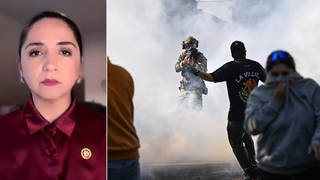
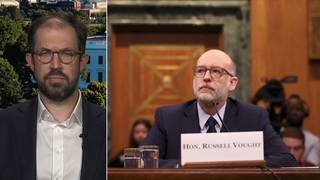
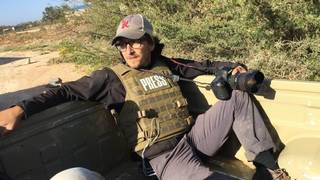
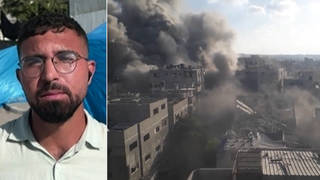






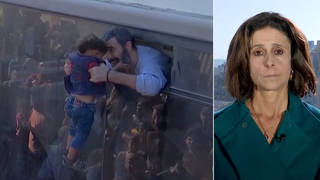
Media Options